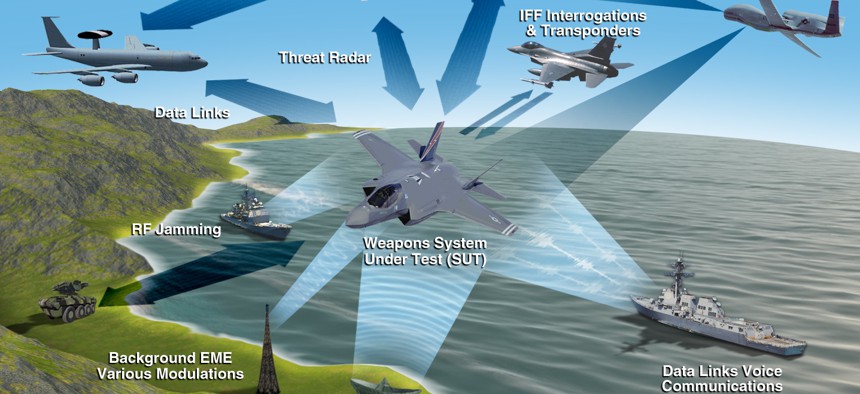Air Force intensifies testing of high powered electromagnetic weapons
Integrating high power electromagnetic technologies with electronic warfare will increase effectiveness of spectrum warfare.
The Air Force Research Laboratory at Kirtland Air Force Base, N.M., is turning to radio frequency and microwave experts at companies such as Raytheon and Booz Allen Hamilton to conduct experiments with high power electromagnetic (HPEM) technology for such applications as disrupting computers, aircraft, or electric grids.
HPEM EW has attracted the attention of the U.S. Air Force’s Directed Energy Directorate’s High Powered Electromagnetic Division because it offers the potential to enhance missile defense and electronic warfare capabilities.
An HPEM integrated weapons system is a type of directed energy weapon that travels at the speed of light, is used covertly, and targets electronic systems instead of people. The system uses an antenna to emit electromagnetic energy from the power source to the target.
Outputs of HPEM technology can either be in wave or pulse form. Waves provide narrow band signal and pulses provide wide band signal. Pulses are the preferred form when there is a large amount of energy being transferred.
Electromagnetic pulses can enter the enemy system through various paths. Some signals will induce currents on external conductors—such as wires and antennas—which then go through to the systems interior. Other signals may couple to exterior metals which reradiate to the internal conductors. Signals can also enter through any holes in the exterior of the system, said the report.
Once the signals have entered the system they can disrupt it either temporarily or cause permanently damage.
If the system is temporarily disrupted, it can either continue to operate or be shut down. However, in either case it is not damaged.
Antenna size determines the amount of energy that can be transmitted to the target from a certain range. The need for these HPEM weapons to be easily portable limits the maximum intensity that can be delivered to a target system.
Raytheon was awarded a $10,000,000 contract for identifying and developing HPEM technologies in May of this year. This technology could complement and enhance mission effectiveness of the cyber and EW communities, said the Department of Defense press release.
These experiments explore parameters including carrier frequency, pulse repetition frequency, and incident power density in order to determine the ideal ratio for electronic warfare operations. This allows them to determine the optimal antennae size that also fits portability requirements and has a strong, long-range, power density.
The goal of these experiments is to maximize the amount of electromagnetic energy that makes it to the enemy target, according to Raytheon.
According to DOD, this will be done through study, analysis, and information scenarios in which HPEM can be used for cyber or EW applications, conduct, experiments, and demonstrate concepts.
Researchers at the Air Force are anticipating this HPEM technology will enhance field experiments such as Black Dart and Vigilant Hammer when integrated with existing cyber and electronic warfare systems.
This project is in support of High Power Electromagnetics Cyber Electronic Warfare Applications program.
Work on this project will be conducted at Kirtland Air Force Base, N.M., and is expected to be completed by August 2020.




